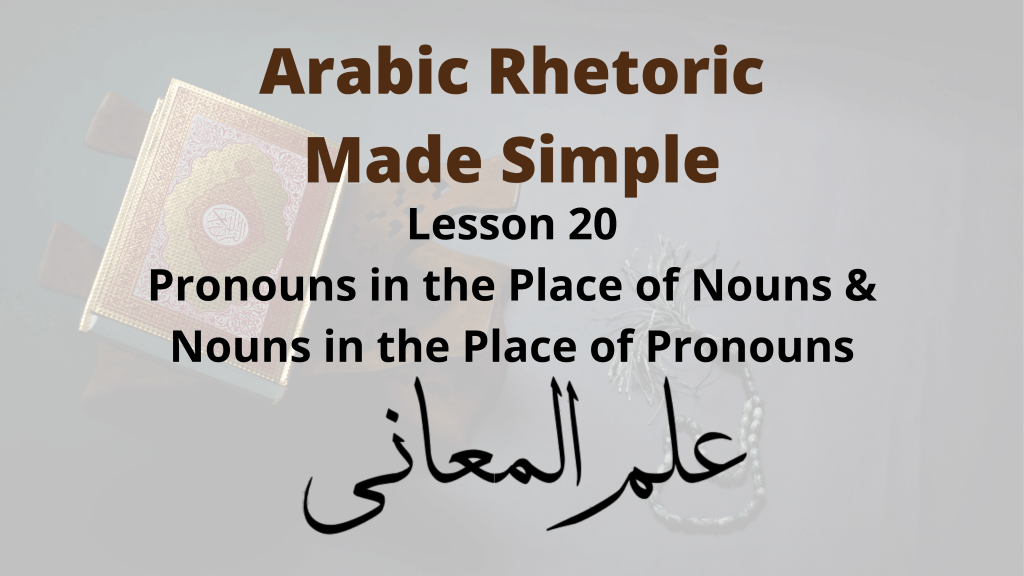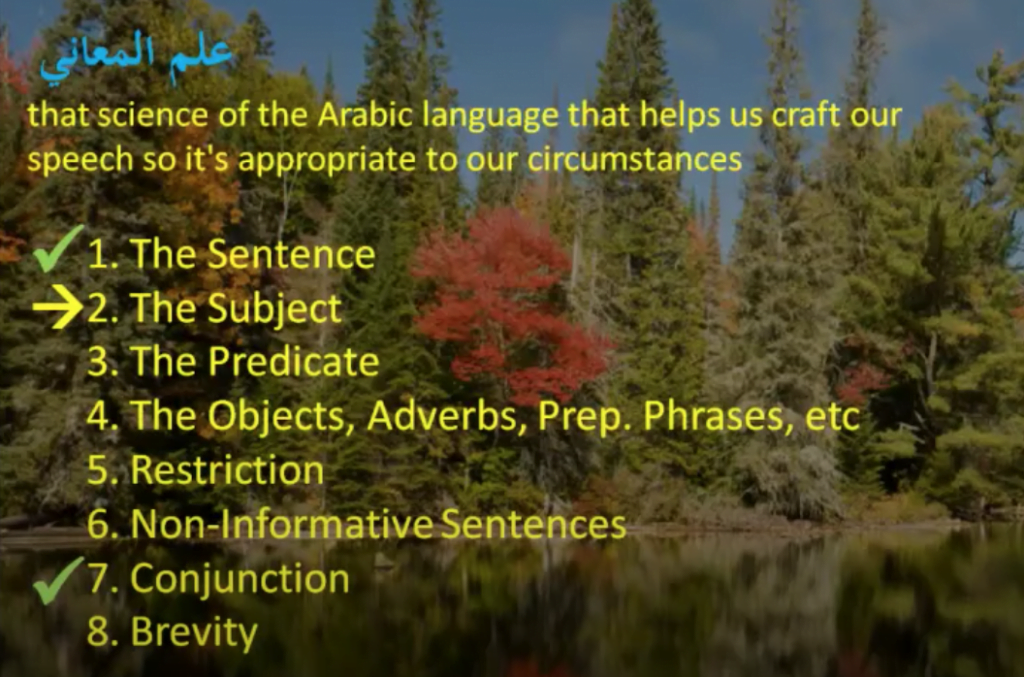In this lesson on Balagha we are going to learn about using a pronoun in the place of a noun, and using a noun in the place of a pronoun.

Just to get our bearings, remember that balagha (Arabic rhetoric) is that science of the Arabic language that helps us craft our speech so it is beautiful and convincing, and it is appropriate to our circumstances and our audience. The ultimate goal of balagha is to understand the linguistic gems of the Qur’an.
Balagha is actually 3 separate sciences:
- علم المعاني (Ilm ul ma’aani)
- علم البيان (ilm ul-bayan)
- علم البديع (ilm ul-badee’)
علم المعاني (Ilm ul ma’aani) is that sub-science of balagha that teaches us all the things that can happen in an Arabic sentence. And all the concessions that grammar leaves us with, and which one of those to choose in a given circumstance.
Ilm ul ma’aani is then divided into 8 chapters:

Table of Contents
What we have covered so far
We are on the second chapter of ilm ul ma’aani, talking about the subject of a sentence and the various things that can happen to it.
First, we learned why you would mention or omit the subject.
Then we learned if you mention it, what are the various forms it can come in, and when to use which. For example, as a personal pronoun, proper noun, indefinite noun, demonstrative pronoun, relative pronoun, possessive phrase, or definite by way of Al-, etc.
Then we learned, once you have chosen a form for the subject, what are the ways to extend it; by adjectives, emphasis, badal, or atf bayaan.
Finally, we learned, once you have decided exactly what your subject is going to look like, with all its extensions and such, what are the places in the sentence that you can put it in. And what effect does hastening or delaying the subject have.
Before we close the chapter on the subject, there are a few concluding lessons.
All the lessons we learned so far in the subject were designed to help us make decisions to satisfy the requirements of our speech, as per the mandate of balagha.
But now we are going to look at a few lessons that teach us how to satisfy, not the apparent requirements of the situation, but the deeper and the more subtle requirements.
To that end, we are going to look at why you would use a pronoun when we would expect you to use a noun. This is called وضع المضمر موضع المظهر.
We are also going to look at why you would use a noun, when we would expect you to use a pronoun. This is called وضع المظهر موضع المضمر.
Pronouns in Place of a Noun
The way a pronoun works is that you mention a noun, then every time you need to refer to that noun, you simply use a pronoun. But in rare cases you might come across a situation where you see a pronoun, and there is apparently no noun that it is referring to. Neither explicitly, nor implicitly. This is وضع المضمر موضع المظهر.
Why do we do this?
When you mention a pronoun that apparently doesn’t refer to anything, your listener gets a bit of a shock. Like, wait what are you referring to? He starts paying a bit more attention, trying to think of what this pronoun could refer to. He listens more attentively, waiting for you to mention something so he can make sense of your conversation. Creating this type of shock and anticipation is called تشويق in balagha.
You may have noticed that تشويق is becoming sort of a theme and it is going to come up again in the future also.
Dameer ush-Sha’n (ضمير الشأن)
The only systematic place where this happens is in ضمير الشأن /dameer ush-shan/.
Recall from Arabic grammar that a ضمير الشأن is a singular third person pronoun that comes before a sentence.
For example:

This sentence is الله أحد (Allah is One), and there is a pronoun before this sentence: هو.
The scholars of balagha say that the speaker formulates an idea in his mind. Then he expresses that idea through his speech at which point it becomes a sentence.
The ضمير الشأن /damir ush-shan/ is a pronoun referring to that idea in your mind. But because your listener doesn’t know what is in your mind, he is a bit confused as to what this pronoun refers to, unless you have just done وضع المضمر موضع المظهر.
Based on this explanation a good English translation for ضمير الشأن in قل هو الله أحد would be something along the lines of “The fact of the matter is Allah is one”.
Non-pronoun in Place of a Pronoun
Again, the way a pronoun works is that you mention a noun, then every time you need to refer to that noun you simply use a pronoun. But sometimes what happens is that you mention a noun for the first time and then when you need to mention it again you use a noun again, not a pronoun. This is وضع المظهر موضع المضمر.
We are going to go through a few reasons why you would do this.
Ism ul-Isharah in Place of a Pronoun
First let’s consider the case where the noun in the place of a pronoun is an اسم إشارة. The reason we are looking at اسم إشارة separately is because اسم إشارة is also used to refer to something that is already being mentioned, so it is kind of in the same category as pronouns.
Our example is the following poem. The poet says:

First the poet mentions something, which is the fact that so many intelligent people are poor and yet so many idiots are rich. Now the poet wants to refer to this fact and say that it is what causes people to become astonished, and what causes scholars to go astray. But the poet doesn’t refer to this fact by saying it is what causes people to become astonished. Instead he says this is what causes people to become astonished.
It is okay to refer to a previously mentioned noun using both اسم إشارة and pronouns, like I said. But اسم إشارة is only used when the thing you are referring to is tangible, yet the fact which the poet is referring to is obviously not tangible. It is a fact, an idea. The reason he does this is because even in English, instead of saying: “it is what causes people to become astonished”, we would say: “this is what causes people to become astonished”. Or even more exaggeratedly, “this is the very thing that causes people to become astonished”.
In essence, we use an اسم إشارة in the place of a pronoun to insinuate that the thing is tangible and to make sure it is clear what we are referring to because what we say about it next might be a bit strange and unexpected, so we want to make sure that it is engrained in the mind of the listener that this is what we are talking about.
Another reason to use اسم إشارة in the place of a pronoun is because اسم إشارة again is used to refer to something tangible. What you might do is use an اسم إشارة (even though you should have really used a pronoun) to make fun of someone, insinuating that he doesn’t really understand anything unless it’s tangible.
What you might also do is use an اسم إشارة (even though you should have used the pronoun) to flatter someone, insinuating that to him, even intangible things are as good as tangible.
There are other reasons for this also. Many of which we have already studied in the lesson on اسم إشارة.
Actual Nouns in Place of Pronouns
Let’s consider cases where the noun in the place of a pronoun is not an اسم إشارة. One of the reasons this happens is to firmly establish the noun.
Like Allah says:

Obviously, this isn’t the subject, but notice بالحقّ appears twice, where we would expect it to appear once. Then we would use a pronoun to refer to it. بالحقّ أنزلناه و به نزل. The reason a pronoun isn’t used is so that بالحقّ can be firmly established in the listeners mind. This happens in English: “It was with wisdom that we revealed it. and it was with wisdom that it came down”.
Another reason to use a non- اسم إشارة in the place of a pronoun is to instil awe in the listener. Like when the general of an army congratulates a lower ranking officer on a job well done, he says: “Your country is proud of you”. You would expect the general to say: “I am proud of you” or “We’re proud of you”. He probably doesn’t even have the authority to speak on behalf of the country anyway. He says it like this: “Your country is proud of you” because it instils more awe in the officer. This awe could be for honour, such as in this case. Or for fear or for a number of reasons.
We will talk about one other reason to use a non اسم إشارة in the place of a pronoun. That is to show humility, in the hopes of mercy and compassion.
For example, the poet says:

Notice the poet didn’t say “I come to you”, instead he says “Your slave comes to you”. That is because the term “your slave” shows humility, and it is more likely to be met with mercy and compassion.
How to Recognize Beauty in Speech
Let me just take this opportunity to make an important point. Balagha is not just about rules like grammar. It is actually a fluid art form. More important than memorizing rules, it is learning to recognize beauty in speech and developing that aptitude and skill. This skill is language agnostic. In fact, I can re-do all these lessons and use only English examples, and scrap all the Arabic. You would be learning the same thing. My point is that if you can learn to recognize beauty and articulate it in any language, that skill is what will make you a master of balagha, Arabic balagha. You can read dozens of books on the subject, but if you can’t recognize and articulate beauty, you don’t know balagha and you cannot evolve as the language evolves.
So learn to develop that aptitude in any language.
Let me give you an example. I have 2 sentences, and the theme here is for computer science, because I am a programmer and this is my field.
The first sentence is: “But the Sandy bridge architecture is an improvement over the Nehalem architecture”.
The second sentence is: “But an improvement over the Nehalem architecture is actually the Sandy Bridge architecture”.
Anybody whose mother tongue is English knows the difference between these two sentences and knows when to use which. But if I ask him, he can’t really explain the differences intelligently. Well, the average person probably can’t. That is all balagha really is at the core; learning to take these differences out of the sub-conscious and learning to articulate them in the conscious.
I will give you an example with these two sentences.
Let’s say a person comes into the room and the first sentence he hears is the first one: “But the Sandy bridge architecture is an improvement over the Nehalem architecture”. One of the things this person picks up from this is that both the Nehalem and Sandy bridge architectures had already both been discussed before he came into the conversation. Now let’s say he walks in and the first thing he hears is: “But an improvement over the Nehalem architecture is actually the Sandy bridge architecture”. Now the impression he gets is that the Nehalem was being discussed prior to his arrival, but Sandy bridge wasn’t. This is the first mention of Sandy bridge. Why and how is that? What are some other differences between these sentences? This is what balagha is all about. I encourage everyone reading to make these skills your goal. Do it in whatever language you are comfortable with and Arabic will just come naturally.
- Proceed to next lesson: Iltifaat in the Quran (Switching Person)
- Return to index page: Intro to Ilm Ul-Ma’ani
- Start free lessons: Sign Up for Free Mini-class